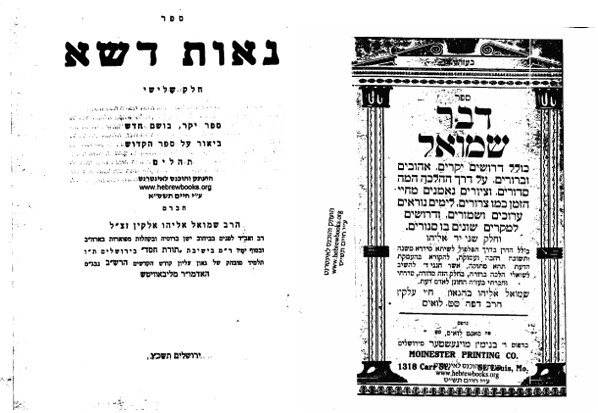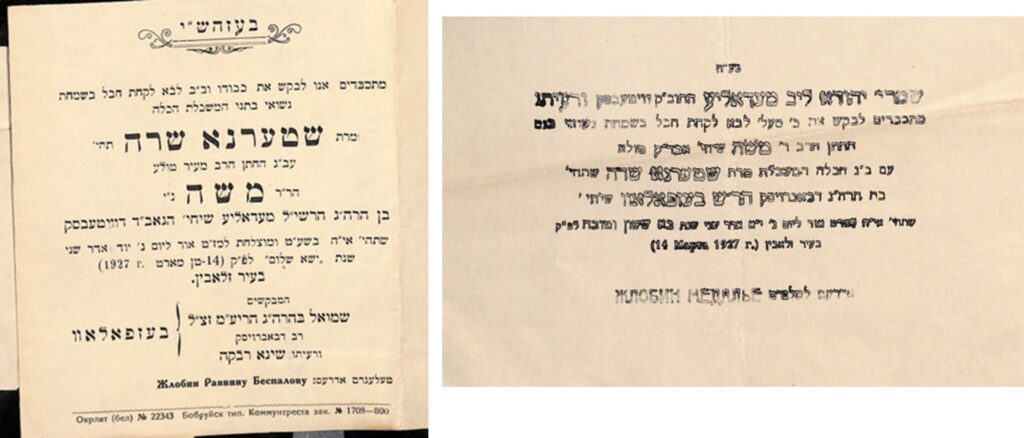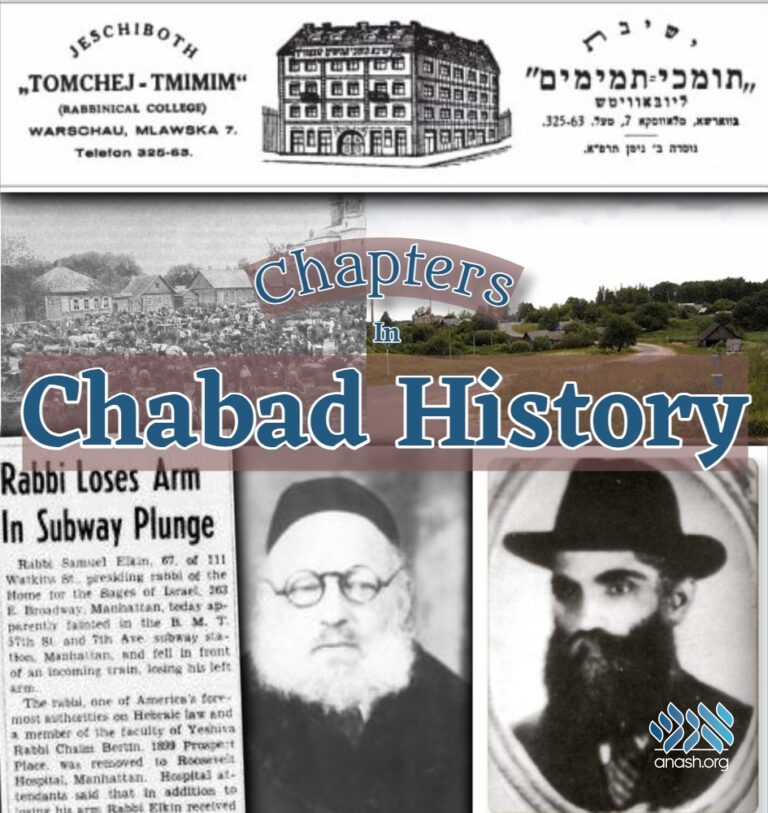Chapters in Chabad History 2: The fire that destroyed Tomchei Tmimim Zhembin, the Rebbe Rashab’s regulations for fundraising, and following the tracks of famous Zhembin alumni.
By Nochie Wolf – Anash.org
Tomchei Tmimim Zhembin Part 2
Kuvlitz
During Nissan 5660, a terrible fire broke out in Zhembin; it destroyed the homes of many of its residents and the Yeshivah was completely decimated. Immediately, the Yeshiva was transported to Lubavitch where they stayed until a long-term option was found.
Following Shavuos, a raffle was held between the towns Kuvlitz and Dokshitz who were both vying to host the Yeshivah; Kuvlitz was chosen, and the teachers and bochurim all departed. The community excitedly received them and provided the Yeshivah with a new Beis Medrash and opened their homes to operate as the bochurim’s sleeping quarters.

However, within a year the Yeshivah encountered a crisis that compelled them to move again. Rumors of secular influences penetrating the walls of Yeshivah and impacting some of the bochurim had reached the Rebbe Rashab. Deeply disturbed he turned to the Frierdiker Rebbe in a letter:
“… I request that you respond to this [letter] thoroughly in order to somewhat calm my spirits; to inform me that all matters are under suitable supervision, that the mashgichim are carrying out their responsibility and the bochurim are fulfilling their obligation through learning Chassidus, Nigleh, and avodah– each one according to their capacity. Because the concerns of my heart and soul are in their regard this is my ultimate desire and will; that they should be subdued in the service of Hashem all their days. Hashem should protect them from an evil occurrence and an evil eye.”
Upon further investigation, it was discovered that a group had been formed by members of the Haskalah movement to influence and lead astray the bochurim of Tomchei Tmimim. They had successfully managed to impact one bochur (and an additional bochur in Lubavitch at the same time) who became despondent in his Avodas Hashem and learning, and was also sharing his beliefs and attitudes with others.
However, there emerged a difference of opinion regarding the immediate repercussions. The Frierdiker Rebbe and the Yeshivah’s board felt that the Yeshivah must leave Kuvlitz and had begun plans for the resettlement. Reb Shmuel Gronem, however, felt that there was no immediate threat of outside influencers and wrote to the Rebbe Rashab that the Yehivah should remain in Kuvlitz.
The Rebbe Rashab decided that the Yeshivah must leave[1], so the thirty bochurim returned to Lubavitch where they were to remain temporarily. Because of the excess number of bochurim, two new branches of Tomchei Tmimim were opened following Shavuos; one branch in Horodozhitz and another in Nevill, absorbing forty bochurim from Lubavitch.
In that same letter, the Rebbe Rashab cautioned the Frierdiker Rebbe that he ensures no discord is developed between the present mashpia in Lubavitch, the Rashbatz (who assumed the position following Reb Chanoch Hendel’s passing in 5660) and Reb Shmuel. The Rebbe Rashab felt that bochurim might be attracted by the novelty of a new mashpia and therefore set forth that the bochurim should only attend shiurim of their current mashpia.
In the winter of 5662, the rebuilding of the Yeshivah in Zhembin was completed and the bochurim returned with Reb Shmuel.
Ending
Very little is written about the last three years of the Yeshivah in Zhembin, and in 5665- following the passing of the Rashbatz, head Mashpia of Tomchei Tmimim Lubavitch- Reb Shmuel Groinem was appointed in his stead. The Yeshivah came with him and this effectively ended the Zhembin branch of Tomchei Tmimim.
Fundraising
While not exclusively connected to the Zhembin branch of Tomechei Tmimim, the fundraising to support Tomchei Tmimim offers a fantastic insight into the inner dimensions of the Yeshivah and its operations.
The Yeshivah’s financial responsibilities included dorm and board, clothes for students who couldn’t afford their own, stipends for married Yungerleit, medical needs of the bochurim, and even arrangements for army exemptions. The budget would vary depending on the year and the events therein. All the annual collections and expenditures were meticulously organized and recorded and are all available today.

Originally, with a smaller student body, the Rebbe Rashab instituted a restricted method of fundraising. The policy he established was that money should only be collected from Anash and selected trusted individuals. The Rebbe Rashab explained his opposition to fundraising by casting a wide net for two reasons: Early on, the prospect that the Yeshivah could prove unsuccessful and have to be closed would be complicated by a diverse group of donors. Additionally, only by collecting from trusted people would he be guaranteed complete control over the Yeshivah’s acceptances and policies and not be coerced into decisions by influential donors.
For these reasons, the Rebbe Rashab refused to allow shadarim to be sent to nearby cities (despite the Frierdiker Rebbe’s requests in that regard), until in 5660 the dire financial situation of the Yeshivah necessitated an additional source of fundraising. These concerns also applied to individuals: the Rebbe Rashab refused to accept money from people he felt would not be conducive to the ultimate goal of the Yeshivah. In a letter to the Frierdiker Rebbe during a time of serious financial difficulty, the Rebbe Rashab refused to allow an individual to be approached to become a key donor because, “he is an extremely immethodical person and his beliefs are ever changing (albeit they are always for the positive, but, nonetheless changing[2]).”
The year 5660 was a particularly difficult financial year for Tomchei Tmimim and presented significant challenges to the Yeshivah’s management. Besides the more straightforward dilemma of raising money for the fast-growing Yeshivah, vocal opponents of Tomchei Tmimim, especially from the Zionist quarters, were openly disparaging the Yeshivah, impacting its public image.

After receiving letters of concern from Chassidim in various affected cities, the Frierdiker wrote a stunning letter, passionately dispelling the hateful accusations, and expressing the vital work Tomechei Tmimim accomplishes. The letter was distributed in many cities and was very well received, even eliciting apologies from certain Zionist leaders.
One of the extraordinary efforts undertaken to raise money was the preparation of a new edition of the Tanya. The proceeds of its sale were to be dedicated to the support of Tomchei Tmimim. The goal of this printing was to correct many of the textual errors that had crept into the text over time. The Rebbe Rashab was heavily invested in this endeavor and commented that he spent four months toiling in the work and had made over one thousand corrections.

However, the monetary situation did not improve, and at the end of the year, the Yeshiva was almost three thousand rubles in debt.
Eventually, these difficulties affected the Frierdiker Rebbe’s health and the doctors instructed that he rest in a health resort. After paying off the debt with a loan from his personal gemach, he took leave. And since the Rebbe Rashab was on datche, the Frierdiker Rebbe transferred all the financial responsibilities of the Yeshivah to his grandmother Rebbetzin Rivkah.
The deficit was ultimately paid off by the board of the Yeshivah, but this crisis led the Rebbe Rashab to call for added fundraising responsively on regular anash and “small amounts collectively form great sums[3].”
Notable Personalities
Reb Shmuel Eliyhu Elkin
Reb Shmuel was born in the town of Novoalexandrovsk, Russia, where his father served as Head of the local Beis Din, Rav of a shul, and a Ram in the yeshiva. At the age of fourteen, he left home for Yeshiva; he spent a few years learning in Telz and Vilna -and perhaps encouraged by his uncle the Rashbatz- he came to Lubavitch.
The Rebbe Rashab displayed a special kiruv towards him and invited him- together with Reb Shlomo Zalman Havlin, who later headed a branch of Tomechei Tmimim- to join his Tanya chavrusa with the Frierdiker Rebbe[4].

After his first wife tragically died in a fire, he married Leah Naomi, the daughter of a prominent Lithuanian Rav and Av Beis Din and served as a Rav in various cities[5].
During 5667 violent pogroms broke out and Reb Shmuel decided to leave the country. He (together with his wife and ten children) departed and began a life as a Rabbinical “globetrotter.” His first destination was London, where he served as an Av Beis Din and assisted Rabbi Nosson Adler, then the Chief Rabbi of London.
In 5670 he headed to America where he served as a Rav in the cities of Worcester, Baltimore, Syracuse, St. Louis (he was sent to this congregation by the Rebbe Rashab), New Haven, Passaic, Chicago, New Haven, and New York. He was an extremely influential and highly acclaimed Rav; Rabbi Dr. Phillip Klein, a central Rabbinic figure in the American Jewish landscape once wrote in his regard that, “from his mouth we live and it is forbidden to doubt him.” In Chicago, Reb Shmuel organized much of the Frierdiker Rebbe’s visit to the city. He even formed a Yeshivah which the Frierdiker Rebbe described as operating “ with the flavor and spirit of Tomchei Tmimim[6].”

Reb Shmuel was famous for his Shabbos sermons which would often attract large crowds and in 1917, while in St. Louis, Reb Shmuel printed his first sefer, Dvar Shmuel, a collection of these sermons. In his introduction, he writes that “only pictures and drawings are present in today’s Torah publications and the sweet words of our holy Sages are given only marginal importance.” The goal of this sefer, he writes, is to present classic, non-watered-down Torah in a style that is appealing to all.

In 5716 he moved to Eretz Yisroel where he served as Rosh Yeshiva of Yeshivas Toras Chesed and published a three-volume set of his pirushim on Tehillim. He passed away in Adar 5721 and is buried there. In many of his published seforim, Reb Shmuel signed off as “תלמיד מובהק של גאון עליון קודש הקדשים הרש”ב נבג”ם האדמו”ר מליבאוויטש.”
Reb Shraga Feivel Zalmanov
Reb Shraga Feivel was born into a well-known Chabad family; his father Reb Yechiel Michel Yehuda Leib was an especially devoted chossid of the Rebbe Maharsh and known as a serious oved Hashem
At age 15 he came to Lubavitch to join the Yoshvim and when the Yeshivah in Zhembin opened, he was sent as part of the first group. He spent two years in Zhembin before he returned to Lubavitch, where he continued learning and served as a choizer for the Rebbe Rashab’s maamorim.

During his time in Lubavitch, Reb Shraga Feivel and the Frierdiker Rebbe learned together in a secret chavrusa. It was at a time when the Frierdiker Rebbe had become sick and his doctor instructed him to take additional rest. Unbeknownst to his parents, when the Frierdiker Rebbe retired to his room he had arranged with Reb Shraga Feivel to learn the Mitteler Rebbe’s Shaar Hayichud V’hoemuna together- through the window.
Once, the Frierdiker Rebbe accidentally left his notes out and the Rebbe Rashab discovered their arrangement. He allowed the chavrusa to continue and told the Frierdiker Rebbe about the satisfaction he received from reading the notes. At one of the Frierdiker Rebbe’s sheva brochos the Rebbe Rashab instructed Reb Shraga Feivel to recount this story.
After his wedding to the daughter of Reb Yosef Horowitz (Reb Yuzik Varshaver), a prominent and wealthy chossid, Reb Shraga Feivel moved to Warsaw. In a yechidus before he left, the Rebbe Rashab directed him to enter business and cautioned him “Do not change your hat, keep wearing your tzitzit visibly, and don’t daven a Kotzker davening[7].” He merited to host both the Rebbe Rashab and the Frierdiker Rebbe when they came to Warsaw.

In 5681, Reb Shmuel together with a few noted Chassidim, formed a branch of Tomcheii Tmimim in Warsaw. The impetus for its opening is a story too: Reb Berel Moshe Shmotkin was learning Tanya with a large group of bochurim in a Litvishe Yeshiva and at the close of the zman, their Rosh Yeshiva demanded that they end the arrangement. Upon hearing this, Reb Berel decided to open a Lubavitche Yeshiva which they all joined.
The Yeshiva grew tremendously and already in the second year there were more than one hundred bochurim. Overtime, the staff of Yeshivah included figures such as Reb Alter Simchovitch, Reb Yehuda Eber, Reb Avraham Shimon Engel (Reb Shimele Zhlichover), and Reb Dover Garfinkel (Reb Berele Kurnitzer) and the student body was in the hundreds.
Reb Shmuel was killed by the Nazis ym”sh in 5702.

Reb Shmuel and Shneur Zalman Bespalov
Born to the legendary chossid Reb Yaakov Mordechai Bespalov, the Paltaver Rav, the two brothers were from the first class of Tomchei Tmimim. Their father was a chavrusa of the Rebbe Rashab, known amongst chassidim as a Beinoni, and someone whom the Rebbe Rashab described as his close friend[8].
Since the Rebbe Rashab’s datche location was in the same area as the Bespalov’s, during the summer of 5658, the two brothers had a morning chavrusa with the Frierdiker Rebbe. When Reb Shmuel and Shneur Zalman returned to Lubavitch, the Rebbe Rashab requested to see their sleeping location. He said, “I want to see where they sleep. How they sleep, I’ll know; after all, they’re chassidishe bochurim – but I want to know where they sleep[9].”
Reb Shmuel married the granddaughter of the Chabad-Kopust Rebbe, Reb Shmaryahu Noach Schenerson of Bobruisk. He briefly served as the Rav of Paltava after his father’s passing and after vacating that position he moved to Charkov, where he served as Mashpia[10].

Following the passing of the Kopuster Rebbe, his chassidim sought a new Rebbe and specifically a grandchild of Reb Shamryahu Noach, since he had requested such in his will. At their request, the Frierdiker Rebbe encouraged Reb Shmuel to fill his grandfather’s position. But, Reb Shmuel declined the role of Rebbe and was instead appointed as Rav of the community. He continued in this role even after ‘officially’ vacating the position due to Communist pressures in 5689.
In 5701, the Nazis ym”s began the extermination of the Jews of Bobruisk and gathered them all in the nearby village of Kamenka. Survivors related that at the time of execution, Reb Shmuel loudly warned the officers that they would suffer the same death as all Jew-haters had throughout history. The Nazi commander, furious, commanded that Reb Shmuel’s tongue be cut off, and following that he was murdered with the other kedoshim[11].

After Reb Shneur Zalman’s wedding, he was appointed as the sgan menahel of Tomchei Tmimim, serving as the Frierdiker Rebbe’s deputy. Later he moved to Cherson and opened a branch of the Yeshivah there with his younger brother and others.
In 5680 he moved to San Francisco where he opened a Chabad Shul, was active in communal matters and resided until his passing.
He had a very warm written correspondence with the Rebbe; the Rebbe often sent him new publications of the Rebbeim’s Torah and encouraged[12] him to write his zichronos, which he ultimately did[13]. The Rebbe often inquired about his health and once even expressed how he was worried since Reb Shneur Zalman hadn’t answered the Rebbe’s phone calls[14]! He passed away in 5721 and is buried in New York near the Ohel.
[1] אג”ק מוהרש”ב ח”ב ע’ רמח
[2] אג״ק מוהרש״ב ח״ג עמ’ רפז
[3] מכתב הנ”ל
[4] המשפיע עמ’ כא
[5] https://col.org.il/news/35922
[6] אג”ק מוהריי”צ חי”א ע’ סא
[7] https://www.geni.com/people/Shraga-Feivish-Zalmanov/6000000008628693825
[8] אג”ק מוהרש”ב ח”ב עמ’ תתיב, אג”ק מוהרי”צ ח”א עמ’ קנב
[9] ספר השיחות תש”ד ש”פ נשא
[10] http://teshura.com/Shemtov%20-%20BM%20-%20Teves%2024%2C%205767.pdf
[11] http://jewish-tour.com/tours/orthodox-judaism/individual-planning-of-the-tours-on-the-subject-of-orthodox-judaism.html
[12] אג”ק ח”ט ע’ רעא
[13] https://www.kramim.info/article/%D7%A7%D7%95%D7%91%D7%A5-%D7%9C%D7%99%D7%95%D7%91%D7%90%D7%95%D7%95%D7%99%D7%98%D7%A9-%D7%A4%D7%95%D7%9C%D7%98%D7%91%D7%94-%D7%95%D7%A1%D7%91%D7%99%D7%91%D7%95%D7%AA%D7%99%D7%94-%D7%91%D7%AA%D7%99-%D7%9B%D7%A0%D7%A1%D7%99%D7%95%D7%AA-%D7%95%D7%97%D7%A1%D7%99%D7%93%D7%99%D7%9D/30362691
[14] אג”ק ח”ז ע’ עז

Discussion
In keeping in line with the Rabbonim's policies for websites, we do not allow comments. However, our Rabbonim have approved of including input on articles of substance (Torah, history, memories etc.)
We appreciate your feedback. If you have any additional information to contribute to this article, it will be added below.